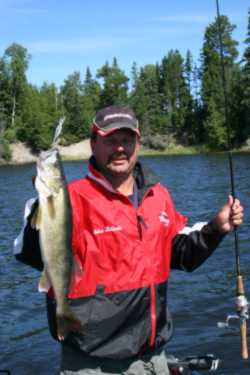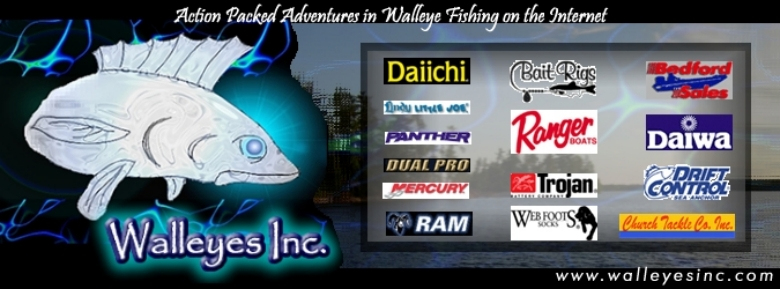| Editor's note: John Kolinski is the 2002 Professional
Walleye Trail Angler of the Year, the 2003 Illinois River
RCL winner and a 17-time championship qualifier. He is
the only anger to fish the PWT and B.A.S.S. at the same
time. His articles can be read in numerous Midwestern
outdoor publications and at several web sites. Kolinski
is sponsored by Triton Boats, Mercury Motors, Lowrance
Electronics, Yo-Zuri fishing line, Normark/Storm Lures,
MinnKota, Lindy Legendary Tackle, Tempress Rod Holders,
Off-Shore Planer Boards, Optima Batteries and Panther
Marine. |
|
All summer long, the joke's been on us. For every walleye
we've been fortunate enough to catch, another 1,000 have ignored
our best hook-up lines.
We've tempted them with natural beauty, sparkly things and fine
dining. We've tried to charm them, impress them and tease them.
All they've done is flip us the fin.
Now it's November.
Now the advantage has shifted.
Now it's time to get even.
Instead of the summertime uncertainty of where these fish are
holed up or what water they're wandering, we know where they
hang. Instead of wondering what will trip their trigger on a
particular day, we know what they want. And instead of spending
hours upon hours looking to connect, we know that it's all about
the night life.
Whether you prefer rivers, lakes or reservoirs, there is a November
walleye bite that will rock your world. You don't need to be
an expert angler to tap this resource. You only need to know
three basic principles -- shallow water, big baits and low light.
A little basic fishology tells us that walleyes make fall migration
runs similar to those they undertake in the spring. They won't
go all the way up into the tributaries or traditional areas
where they spawn, but they won't be far away.
 |
Secondly, the water is cooling rapidly.
That drives baitfish into the shallows where they seek
out the warmest available water, and that attracts walleyes
eager to pack away some fat reserves for the cold winter
ahead.
Any time you couple shallow water with walleyes, the bite
is on. There's only one reason these sensitive, reclusive
fish invade water less than 8 or 10 feet deep -- to fill
their bellies. Our job is to accommodate them.
And while you can probably catch some fish during daylight
hours by probing the depths adjacent to these shallow
areas, there's a lot more action for hot fish at sunset,
sunrise and the period in between, especially if your
goal is a trophy. Big fish don't get that way by making
themselves readily accessible to anglers.
Maybe it's simply the law of nature. The best waterfowling
and deer hunting tends to occur at sunrise and sunset,
too. Maybe it's the security that darkness provides for
baitfish and, in turn, predators like the walleye. |
Typically, I like to head out an hour or so before dark and
fish until 10 p.m. or so, although I know other anglers who
stick it out all night with equally impressive results.
As far as location goes, not just any shallow area will do.
No matter what type of water you're fishing, it's important
to have depth nearby. On rivers, look for shallow sand flats
that fall off sharply into 15 or 20 feet. On lakes and reservoirs,
look for reefs, humps and weed flats associated with deep water.
Seek out structure that has been exposed to the wind. If there
hasn't been much wind on a given day, fish areas where the wind
was blowing into most recently.
Do some scouting during daylight hours. Pinpoint shallow, rocky
reefs with scattered vegetation or flats where the dense weed
growth of June and July is beginning to decay. Areas that are
crystal clear and void of walleyes during the day become a totally
different world after dark. And areas where you've caught 16-
or 18-inchers during the day may well come alive with 5- to
10-pound fish after dark.
On bodies of water with which I'm already familiar, I'll drop
waypoints on my Humminbird 1197 combo GPS and sonar unit to
mark the edges so I don't venture too far into the fish zone
when it's dark outside. On new bodies of water, I'll also mark
a trail with my GPS so I can navigate to these spots safely
after dark.
It's also a good idea to launch as close as possible to the
areas you plan to fish and to carry a compass in your boat in
case a power failure leaves you without electronics. I also
carry an AC-DC spotlight that runs on batteries or plugs into
the cigarette lighter in my Triton boat to help me find my way
around.
The same goes for those sand flats on river systems like the
Mississippi, Wisconsin and Missouri. Make sure you have them
well-marked, and make sure you have a trouble-free route to
and from them.
Presentations can be simple. There are two basic options, and
they're both dynamite. I like to cast big crankbaits over shallow
structure with dying weeds. Normark Husky Jerks and Storm's
shallow Thundersticks in the 5- to 8-inch range are two of my
favorites. Walleyes will explode from the cover of those remaining
weeds to inhale these baits.
I think it's important to go big for two reasons -- because
we're fishing for big fish and because larger baits provide
a bigger profile in the dark. When fish are aggressively feeding
like they are in these situations, attracting their attention
is half the battle.
Crankbaits work well for river walleyes, too, but don't forget
about light jigs and big plastics. While they might drop too
fast or get into too much trouble on reefs, humps and weedbeds,
they can be very effective on sand flats where the current gives
them a little extra buoyancy.
Slip-bobbering is another viable option that produces plenty
of fish, especially on lakes and reservoirs where current isn't
an issue. Try a Thill lighted float rigged with a six-inch chub.
There aren't many things more exciting than watching big walleyes
take a bobber under after dark.
Trolling is another way to attack these fish, but it's also
more problematic. If I'm searching for fish on a large piece
of structure that I know well, I will fire up my Mercury kicker
motor and troll big stickbaits until I find a section that's
holding fish. Otherwise, I prefer to cast the edges while inching
along with my MinnKota Terrova bow-mount powered by Optima Batteries.
Night fishing requires a little extra organization and care
than normal.
Lanterns are fine as long as they are fastened securely and
can't be overturned. Ditto for heaters, although I prefer not
to use them in my Triton. Wear a head lamp or a light that clips
onto a baseball cap to help you find your way around the boat.
Stow away everything except what you're using to eliminate the
possibility of stepping on extra rods or stray crankbaits or,
even worse, tripping over a tackle box and tumbling over the
side of the boat.
Comfort is an equally important consideration. That's one reason
to poke around during the day so you don't feel lost at night.
Comfort applies to the anglers in your boat, as well. I don't
venture out on windy, cold, drizzly or snowy nights. I try to
pick nights when it's relatively calm and the temperatures moderate.
If you're passionate about catching big walleyes, now is the
time to get after them. A good share of the anglers have turned
their attention to ducks, geese and deer.
The water is all ours. It's time to settle the score and take
a parting shot at those walleyes that played hard-to-get all
summer
|
|
Please Check Out these links
below to our site Sponsors
|
|

